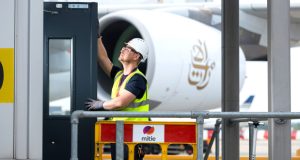London Stansted Airport has taken the unusual step of insourcing its cleaning and waste management – the first major UK airport to do so. Sara Bean visited the terminal to discover how the in-house FM team is managing
London Stansted Airport has been undergoing quite a transformation in recent years, adding new routes to its portfolio, including an Emirates Dubai service. This led to its busiest April on record, when nearly 2.4 million passengers passed through the terminal.
This uplift in passengers feeds into the Stansted Transformation programme, which began in 2018. In February new passenger seating was unveiled in the passenger departure lounge, increasing capacity by 40 per cent, leaving room for over 1,000 passengers in the main departure lounge area. There is also a new quiet 208-seating area away from retail units and passenger thoroughfares, plus a third area offering 160 additional seats on the way to the Satellite 3 departure gates.
The passenger terminal covers three floors and approximately 145 square metres, and at peak times welcomes up to 90,000 passengers a day – around 28 million a year. It experiences peaks and troughs throughout every 24-hour period, with peaks from 4am to 8am, becoming busy again around mid-morning, again at around 6pm and then quietening down at around 10pm. Aside from the main terminal, the airport covers a seven-mile radius, including the roads into the site and a range of onsite buildings, including an education centre and coach station.
This presents quite a challenge in terms of cleaning. Deep cleans are performed predominantly by the night teams during quiet times while the day team maintains passenger areas during busy periods. All of this is now being managed in-house by the facilities team, after the airport brought across nearly 100 members of staff from the previous outsourced contractor and recruited an additional 30 new people. The changes have led to improvements in pay and conditions for staff, with the longer-term aim being to enable the airport to deliver services more flexibly and improve the passenger experience at a time when Stansted is set to be busier than ever.
What makes this change all the more remarkable is that until very recently Stansted didn’t have a defined facilities operation. Each head of department looked after the cleaning in their specific area. This operating model was altered in 2016 when a group of airports, including Manchester and East Midlands, began to look into a TFM solution as the preferred model. This went to tender in April 2016 and was delivered in October of that year. The contract went to Mitie for soft and hard services for each airport.
 “We still have Mitie delivering our hard services, but the soft services side turned out to be a bit of a challenge,” explains Helen Spall, FM Manager for Stansted Airport. “One of the biggest difficulties was that there is zero unemployment in this area, and there are around 12,000 people on the workforce, all on different pay rates.”
“We still have Mitie delivering our hard services, but the soft services side turned out to be a bit of a challenge,” explains Helen Spall, FM Manager for Stansted Airport. “One of the biggest difficulties was that there is zero unemployment in this area, and there are around 12,000 people on the workforce, all on different pay rates.”
Filling these essential roles proved difficult, which is understandable when you consider that according to the British Cleaning Council (BCC), 29 per cent of all vacancies across the cleaning, waste management, landscaping and FM sectors are described as ‘hard to fill’.
Explains Helen Spall: “Under the procured contract, although Mitie were trying to hire staff directly, they were paying minimum wage which meant we were competing with, for instance, mobility people who push the wheelchairs who were paid at a higher rate.” This resulted in a shortage of staff, putting pressure on the night teams in particular to get the deep cleans done.
“When we reviewed the contract, putting in new staff was one of the suggestions, but we just couldn’t get them in, which meant we had two summers when we were more than challenged,” Spall continues. “We got to the point where we needed to do something. I put together a proposal – and although we’d no issues with the waste management aspect, because it was part of the soft services contract we brought that in-house too.”
INSOURCED SOLUTION
The solution was to set up an enhanced cleaning operation which gives the airport direct control over standards and staff. It meant bringing the soft services team in-house and integrating them into Stansted, under the Team Promise title. Spall also undertook a major appraisal of how the soft services team was structured. Under the TFM contract, the management structure comprised an account director and a duty manager in charge of cleaning operatives, which left a big management gap.
 The new structure comprises five new cleaning excellence managers and 12 team leaders, so on each shift there will be a cleaning excellence manager, three cleaning team leaders and a waste team leader.
The new structure comprises five new cleaning excellence managers and 12 team leaders, so on each shift there will be a cleaning excellence manager, three cleaning team leaders and a waste team leader.
Spall explains: “We TUPEd 91 staff over, which was a huge success and they’re all on much better terms and conditions, with an enhanced package and job security. Our cleaning excellence managers are recruited for their leadership rather than cleaning knowledge on the basis that what we want is for them to drive the culture change in the team. Now, with our Team Promise, we’re working on ways to make people feel empowered and feel engaged with the business as a whole. This in turn is exponentially altering attitudes on how they deliver, and they will take more personal responsibility as we move forward.”




